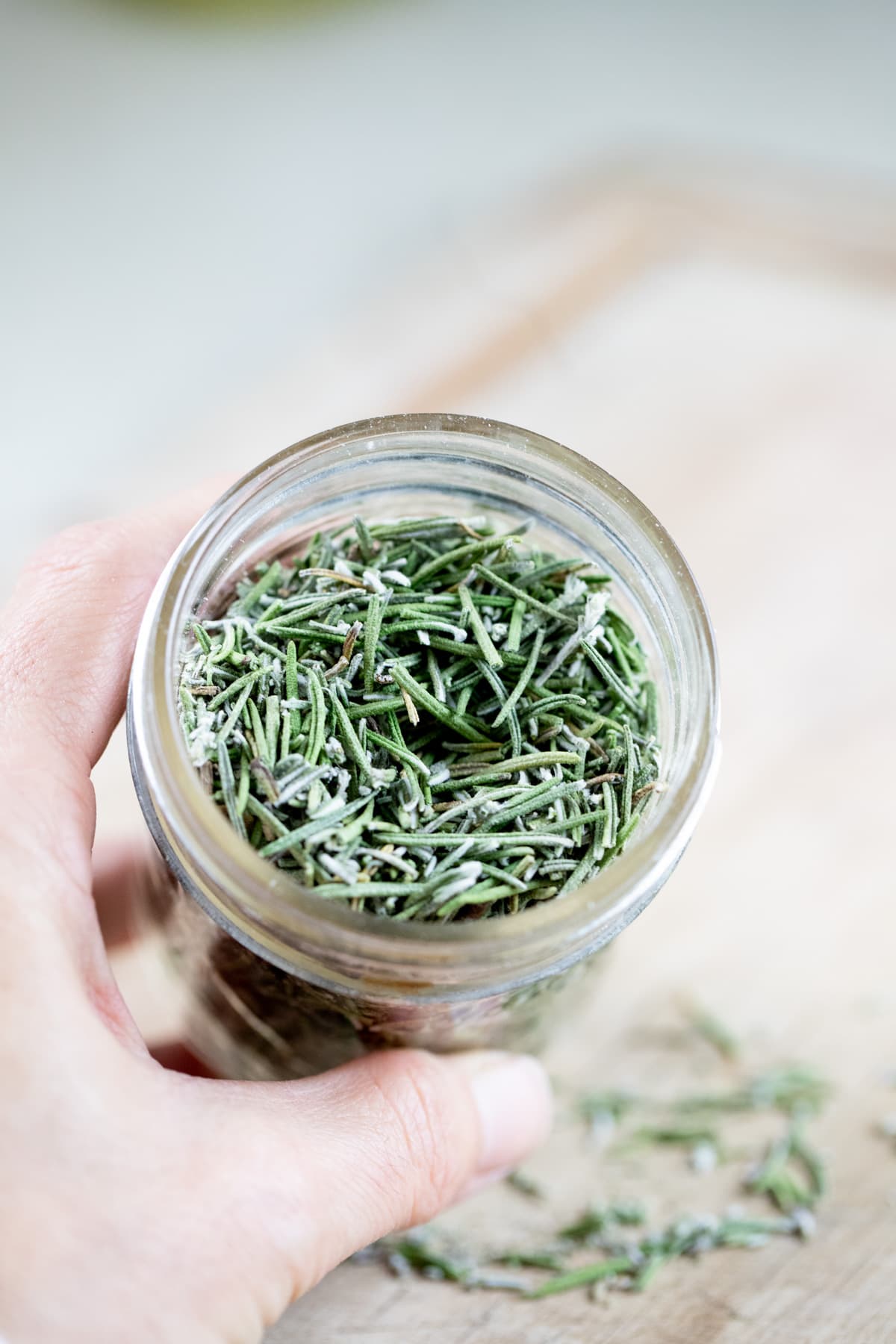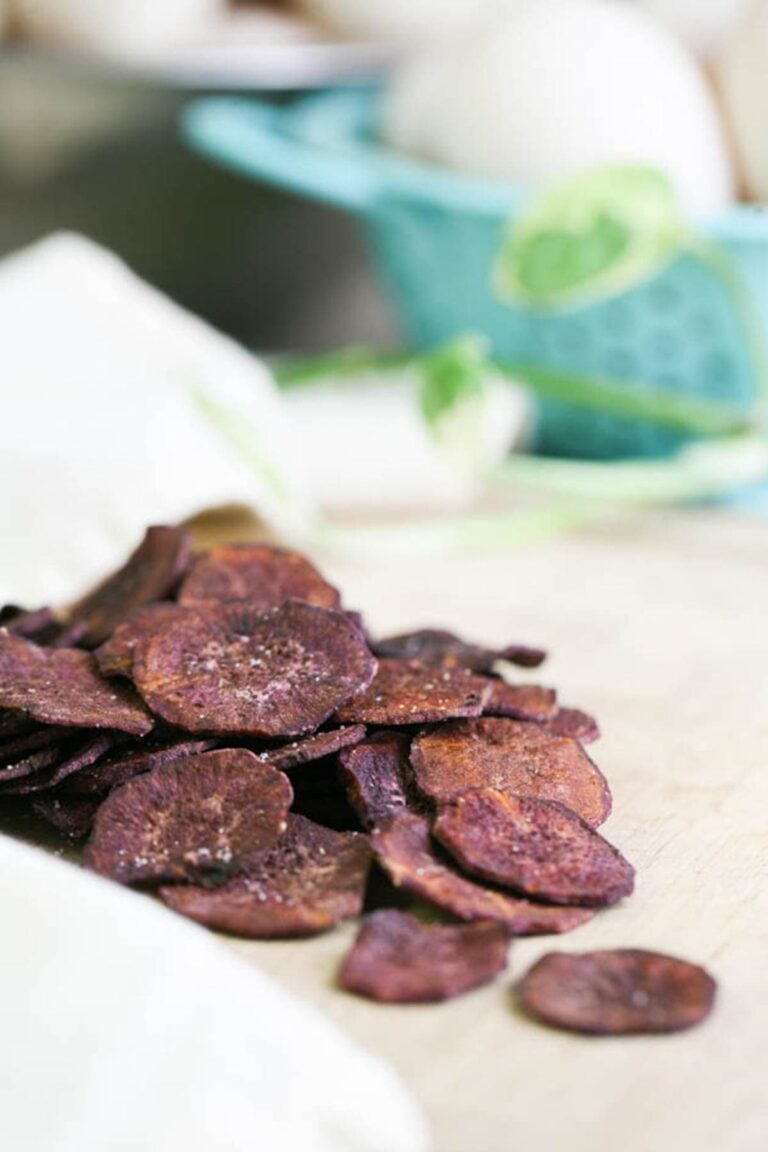How to Dry Rosemary
This post may contain affiliate links, view our disclosure policy for details.
Learn how to dry rosemary easily at home so you can enjoy it year-round. Rosemary keeps its taste when dry and is a great ingredient to have on the seasoning shelf!
It took me a few tries to get a rosemary bush to survive our winter. The first few died from the cold and didn’t come back in the spring. Finally, after a couple of years, I decided to plan my plant close to the house so it’s more protected and cover it in the winter.
That did the trick. It survived, and by the third winter, I didn’t have to cover it again. It was big and strong enough to handle the cold. Now I have two of them, and they are both giant! I’m not complaining…
How to Dry Rosemary…

You see… we LOVE fish around here. We also love potatoes. We eat a lot of fish and a lot of potatoes and these two are not the same without rosemary! I use fresh rosemary during the growing season, and very easily dry plenty of it for winter so I can let the plants be while it’s cold.
Three Ways to Dry Rosemary…
- Hang drying – This method is the most timely for drying rosemary and requires patience but there isn’t any work involved. Tie a few rosemary bundles together with a piece of string or twist tie. Hang to dry and place out of direct sunlight in a warm room with low humidity. Your bundles should dry in two weeks or so.
- In the dehydrator – This is my preferred way to dry rosemary because I can control the temperature and moisture of the drying process. I can also dry multiple herbs at the same time.
- In the oven – If you don’t have a dehydrator, you might be able to dry rosemary in the oven. Place rosemary stems on a baking sheet with parchment paper at a temperature under 160 degrees or the lowest temperature your oven is capable of. Depending on the temperature, this method will take one to four hours (probably).
Ingredients…
- Rosemary – I used a bunch of rosemary and got 1/4 of a cup of dried rosemary.
Kitchen Tools…
- Dehydrator – I use a nice dehydrator that allows me to control the temperature and produces a better result. If you don’t have one, you can still dehydrate rosemary in the oven, hang it dry, or use a cheap (no temperature control) dehydrator. There is more on this in the kitchen notes section below.
- Air-tight storage container (I use jars)
Dehydrating Rosemary Step by Step…

Step one – prep the rosemary. If possible don’t wash the rosemary. If you need to wash the rosemary, make sure it is completely dry before dehydrating.

Step two – dehydrate. Set the rosemary sprigs in one layer on the dehydrator trays, allowing space between them. Place the trays in the dehydrator. Dehydrate at 95 degrees F for 8-10 hours. If the rosemary sprigs are completely dry and crispy (the leaves break easily), you can remove them from the dehydrator. If your rosemary isn’t completely dry, leave it in the dehydrator for another hour or so.


Step three – remove leaves from stems. Use your fingers to remove the rosemary leaves from the stems. Discard the stems. You can choose to leave the rosemary leaves as they are, use your fingers to crumble the leaves, or chop them with a kitchen knife.
How to Store Dry Rosemary…
Once the rosemary is dry, let it cool for a few minutes and then transfer to an air-tight container. You can vacuum seal it or use zip-lock bags. I also love using jars with two-piece lids for herb storage. Not only are the jars functional, but they are also pretty to look at on a shelf.

How to Use Dry Rosemary…
Rosemary seasoning can take recipes from just alright to amazing. It’s the must-have seasoning on your spice rack. Try adding it to these dishes…
- No Knead Artisan Bread – adding rosemary to bread dough adds so much flavor. This is a simple and delicious bread that does not require any kneading. Add the rosemary when you mix all the ingredients.
- Grilled Tilapia – fish and rosemary are meant to marry and live together happily ever after. My mother didn’t add rosemary in this recipe but I usually do. Just stick it in the fish with all the other seasonings.
- Potatoes – sprinkle it over sweet potato fries or regular fries. Add it over baked potatoes or roasted potatoes.
- Season meat – add rosemary to a pork breakfast sausage or one pan chicken and veggies or so many other meat dishes!
How to Make and Use Rosemary Powder…
One of the best things about dehydrated food is that you can turn it into a powder. To make rosemary powder, place the dry rosemary leaves in a coffee grinder and grind them until you get a powder. Store your powder in jars at room temperature. Use the rosemary powder to season your favorite recipes.
Kitchen Notes…
- Washing – It’s better if you don’t wash your rosemary before dehydrating it. If you do need to wash your rosemary for any reason, make sure to pat it dry with a kitchen towel before dehydrating it.
- Mixing herbs – Take into consideration that you can dry all herbs in the same way, in the dehydrator, together. For example, you can dry basil, oregano, parsley, tarragon, thyme, and sage together with your rosemary.
- Rehydrating – You cannot rehydrate rosemary. Once rosemary is dry, we use it dried to season dishes.
- Temperature control – The cheaper Presto Dehydrator is very popular and you can find it at any Walmart or online. It runs at a temperature of 165 degrees F and there is no way to control the temperature. You can use this kind of dehydrator to dry rosemary. Again, for best results, we want to process herbs at a temperature of 95 degrees F but a higher temperature should work. Drying time will probably be shorter, around 3-4 hours or so.
If you haven’t tried drying fresh herbs, start with rosemary. The process is simple, and your food will thank you for it. Have you ever dried herbs? If so, which ones?
More Dehydrating Tutorials…
- How to Dehydrate Radishes
- Dehydrated Kale Chips
- How to Dry Apples in the Oven
- Purple Sweet Potato Chips Recipe
- How to Dehydrate Mushrooms
- How to Dry Cayenne Pepper
- Dehydrating Garlic Scapes

How to Dry Rosemary
Step-by-step instructions on dehydrating rosemary in the dehydrator.
Ingredients
- Rosemary
Instructions
- If possible don’t wash the rosemary. If you need to wash the rosemary, make sure it is completely dry before dehydrating. If you need to wash your rosemary, make sure to pat it dry before dehydrating.
- Set the rosemary sprigs in one layer on the dehydrator trays, allowing space between them. Place the trays in the dehydrator. Dehydrate at 95 degrees F for 8-10 hours. If the rosemary sprigs are completely dry and crispy (the leaves break easily), you can remove them from the dehydrator. If your rosemary isn’t completely dry, leave it in the dehydrator for another hour or so.
- Use your fingers to remove the rosemary leaves from the stems. Discard the stems. You can choose to leave the rosemary leaves as they are, use your fingers to crumble the leaves, or chop them with a kitchen knife.
- Once the rosemary is dry, let it cool for a few minutes and then transfer to an air-tight container. You can vacuum seal it or use zip-lock bags. I also love using jars with two-piece lids for herb storage. Not only are the jars functional, but they are also pretty to look at on a shelf.
Notes
Kitchen Notes:
- Make rosemary powder - one of the best things about dehydrated food is that you can turn it into a powder. To make rosemary powder, place the dry rosemary leaves in a coffee grinder and grind them until you get a powder. Store your powder in jars at room temperature. Use the rosemary powder to season your favorite recipes.
- Mixing herbs – Take into consideration that you can dry all herbs in the same way, in the dehydrator, together. For example, you can dry basil, oregano, parsley, tarragon, thyme, and sage together with your rosemary.
- Rehydrating – You cannot rehydrate rosemary. Once rosemary is dry, we use it dried to season dishes.
- Temperature control – The cheaper Presto Dehydrator is very popular and you can find it at any Walmart or online. It runs at a temperature of 165 degrees F and there is no way to control the temperature. You can use this kind of dehydrator to dry rosemary. Again, for best results, we want to process herbs at a temperature of 95 degrees F but a higher temperature should work. Drying time will probably be shorter, around 3-4 hours or so.
Nutrition Information:
Yield: 1 Serving Size: 1Amount Per Serving: Calories: 4Total Fat: 0gSaturated Fat: 0gTrans Fat: 0gUnsaturated Fat: 0gCholesterol: 0mgSodium: 1mgCarbohydrates: 1gFiber: 1gSugar: 0gProtein: 0g







